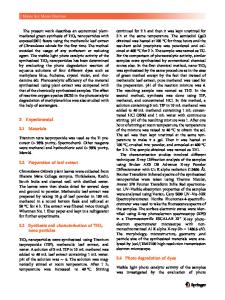Synthesis and Characterization of Nanocarbon-Supported Titanium Dioxide
- PDF / 3,058,149 Bytes
- 6 Pages / 612 x 792 pts (letter) Page_size
- 42 Downloads / 336 Views
1174-V03-06
Title: Synthesis and Characterization of Nanocarbon-Supported Titanium Dioxide Authors: Marcus A. Worsley, Joshua D. Kuntz, Octavio Cervantes, T. Yong-Jin Han, Peter J. Pauzauskie, Joe H. Satcher, Jr. and Theodore F. Baumann Affiliation: Physical and Life Sciences Directorate, Lawrence Livermore National Laboratory, 7000 East Avenue, Livermore, CA 94550, U.S.A. ABSTRACT In this report, we describe recent efforts in fabricating new nanocarbon-supported titanium dioxide structures that exhibit high surface area and improved electrical conductivity. Nanocarbons consisting of single-walled carbon nanotubes and carbon aerogel nanoparticles were used to support titanium dioxide particles and produce monoliths with densities as low as 80 mg/cm3. The electrical conductivity of the nanocarbon-supported titanium dioxide was dictated by the conductivity of the nanocarbon support while the pore structure was dominated by the titanium dioxide aerogel particles. The conductivity of the monoliths presented here was 72 S/m and the surface area was 203 m2/g. INTRODUCTION Titanium dioxide is a widely researched material with applications ranging from photocatalysts to electrodes to hydrogen storage materials [1-9]. However, issues such as absorption limited to the ultraviolet range, high rates of electron-hole recombination, and relatively low surface areas have limited commercial use of titanium dioxide. Recent efforts have focused on combining titanium dioxide with various materials to address some of these issues [8-24]. Titanium dioxide in the presence of carbon (e.g. carbon nanotubes (CNT)) is currently one of the most attractive combinations [13-25]. While recent work has shown some improvements, surfaces areas and photocatalytic activity are still limited. Maintaining high surface areas while improving electrical conductivities, one could envision charging-discharging rates and photoefficiencies that are significantly higher than currently possible. Unfortunately for CNT composites, improvements in electrical conductivity are often not fully realized due to poor dispersion of CNTs in the matrix material, impeding the formation of a conductive network. However, with a mechanically robust, electrically conductive CNT foam, one could imagine simply coating this low-density CNT scaffold with titanium dioxide, yielding conductive nanocarbon-supported titanium dioxide. Here we present the synthesis and characterization of such a high-surface area, conductive TiO2/CNT composite. We recently reported the synthesis of a novel CNT-based foam, consisting of bundles of single-walled nanotubes (SWNT) crosslinked by carbon aerogel (CA) nanoparticles, which would serve as an excellent candidate for the CNT scaffold of the TiO2/CNT composite. The SWNT-CA foams simultaneously exhibited increased stiffness, and high electrical conductivity even at densities approaching 10 mg cm-3 without reinforcement [25]. The foams are stable to temperatures approaching 1000°C and have been shown to be unaltered by exposure to extremely low tempe
Data Loading...











